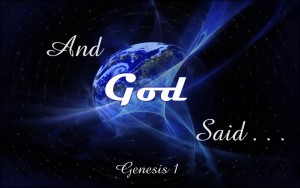When we think about how the universe came into being, Francis Schaeffer, in Genesis in Space and Time, argued that there are basically four options.
Genesis in Space and Time, argued that there are basically four options.
- Once there was absolutely nothing, and now there is something.
- Everything began with an impersonal something.
- Everything began with a personal something.
- There is and always has been something.
Genesis 1 gives us a great deal of information about creation. For the purposes of this post, we will define creation as follows. God created the entire universe out of nothing; it was originally very good; and he created it to glorify himself.
What is the relationship between Scripture and the findings of modern science?
Many people (both Christians and non-Christians) argue that modern science and Scripture cannot be reconciled with one another, but, as Schaeffer wrote, there is no final conflict between modern scientific findings and Scripture. All truth is ultimately God’s truth so when Scripture and science are properly understood, there will be no final conflict.
How might we reconcile the appearance of great age in the universe (i.e., billions of years) that modern science asserts with the relatively young age of the universe (i.e., thousands of years) that many Bible students believe? [NOTE: This is not to say that all Christians believe in a young earth.]
Many Christians disagree about the age of the earth, but in our disagreements, we must be careful not to adopt a theory of origin that would be incompatible with a high view of Scripture. For example, theories such as the “Big Bang,” Darwinian Evolution, and even Theistic Evolution must be rejected by those who hold a high view of Scripture.
So, what then are some theories of origin that still allow for a high view of Scripture?
“Old Earth” Theories of Creation
Here are two theories of origin that account for an “old earth.” The purpose of this blog is not to “expose” the strengths or weaknesses of any of these theories. There are other resources that do this quite well.
First, we have the “Gap” Theory. No, I’m not talking about the clothing store from the 1980s! In its most basic form, the gap theory suggests that there is lengthy (think billions of years) gap of time between Genesis 1:1 and Genesis 1:2 (or between Genesis 1:2 and 1:3). This lengthy period of time would account for the ancient fossil record and the carbon-dating of the world.
According to this theory, this would also allow for the time when Satan and his angels rebelled against God and were cast out of heaven. During this “gap,” Satan and his angels rebelled against God and were cast out of heaven. During this period the earth underwent great cataclysm and was left “formless and void” (Genesis 1:2). God then re-created and reconstituted the earth in six literal days that are described in the rest of Genesis 1.
Second, there is the day-age theory. According the day-age theory, again in its most basic form, the “days” mentioned in Genesis 1 are not six 24-hour days but rather each of these “days” represent a lengthy period of time (think millions or billions of years). During each phase of creation God created what Genesis 1 said was being created on that day.
“Young Earth” Theories of Creation
Here are two theories that account for a “young earth.” Again, the purpose here is not to highlight the strengths and weakness of each of these theories.
First, some people argue that God created everything with with the appearance of age. For example, God created Adam and Eve as fully grown adults. This theory is sometimes called Mature Creationism. So, according the this theory, the apparent age of the earth is just that — it’s only an “appearance.” Those holding this theory would say that God created the fossils as fossils to give the appearance of age.
Second, there is the Flood Geology Theory. This theory would argue that the flood described in Genesis 6-8 would have been so cataclysmic that it would be impossible to use many of our modern dating processes to get an accurate picture of how old the earth is. For example, the age of some fossils is determined by the layer of rock in which they are found. Flood Geology Theory would say that the various layers of rock are unreliable because the flood would have disrupted the various layers.
Either “Old Earth” or “Young Earth” Theories
Finally, there are two theories that can be used to argue for either an “old earth” or a “young earth.”
First, there is the Literary Framework Theory. This theory would argue that the purpose of Genesis 1 was not to describe God’s process of creation, but rather, Genesis 1 actually has a literary framework. Days 1, 2, and 3 are the “form” of creation, and days 4, 5, and 6 are the “filling” of creation. For example, day one of creation corresponds to day four of creation since day one separates the day and night and on day four the sun and moon are set to govern the day and night. Day two corresponds to day five. On day two God separates the sky and the sea and on day five God creates sky animals and sea animals. And day three and day six correspond to one another. On day three God separates the land and sea, and on day six God creates the land animals and human beings.
Second, there is the Historic Creationism (Preformative) Theory. According to this theory, Genesis 1:1-2 is about God creating the entire universe, and then Genesis 1:3-2:4 is about God preparing the “land” for human habitation and flourishing. This view is propounded by John Sailhamer in his book, Genesis Unbound.
These are a few of the various viewpoints about the creation of the universe. I hope this brief overview has been helpful.
For His Glory,
Pastor Brian